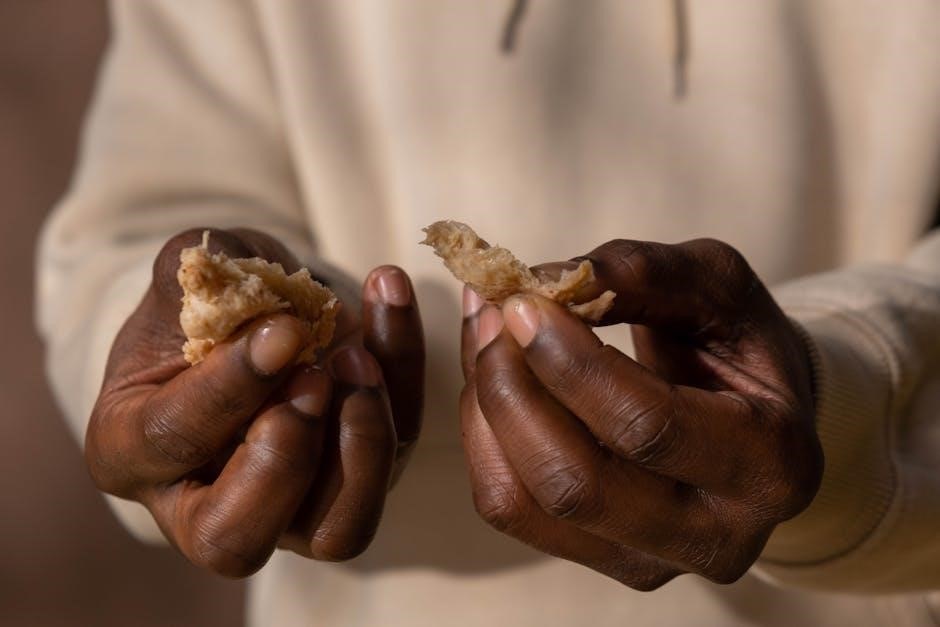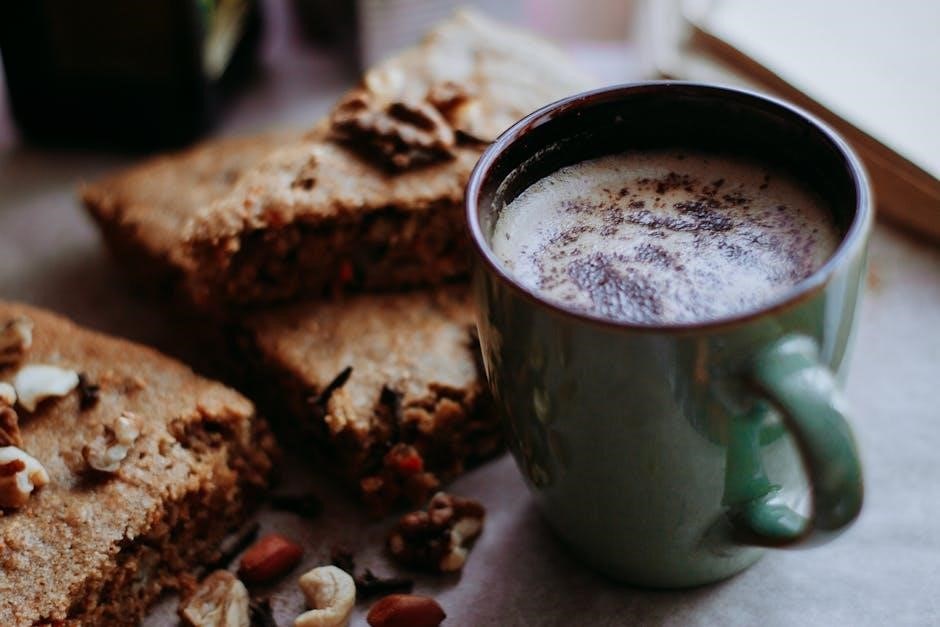The Breaking Bread 2023 PDF explores the cultural, historical, and communal significance of sharing bread, highlighting its role in unity, rituals, and dialogue across societies and eras․
1․1․ Overview of the Document
The Breaking Bread 2023 PDF is a comprehensive resource that delves into the historical, cultural, and communal aspects of breaking bread․ It examines the symbolism of bread in various contexts, such as religious ceremonies, community events, and historical laws․ The document also highlights the role of bread in fostering dialogue, trust, and unity across different societies․ By exploring its significance in both past and present, the PDF serves as a valuable tool for understanding the universal language of bread and its enduring impact on human connections and traditions․
1․2․ Purpose and Significance
The Breaking Bread 2023 PDF aims to illuminate the profound significance of bread as a symbol of unity, trust, and cultural exchange․ By examining its role in historical rituals, religious practices, and community-building events, the document emphasizes how bread transcends mere sustenance to become a catalyst for connection․ Its purpose is to inspire reflection on the universal language of bread, fostering empathy and collaboration in a fragmented world․ This resource is invaluable for educators, historians, and anyone seeking to understand bread’s enduring impact on human society and culture․

Historical Context of Breaking Bread
Breaking Bread traces its roots to ancient traditions, with the Assize of Bread and Ale (1266) establishing early trade laws․ Historical records reveal its role in medieval society․
2․1․ The Assize of Bread and Ale (1266)
The Assize of Bread and Ale (1266) was the first trade law, establishing production and trade rules for bread and ale․ Enacted by Henry III, it set standards for bakers and brewers, ensuring fair practices․ This law protected consumers by regulating prices, quality, and weights, preventing fraud․ It highlights the societal importance of bread and ale, reflecting medieval England’s reliance on these staples․ The Assize laid the groundwork for modern trade regulations, showcasing bread’s central role in daily life and commerce․
2․2․ Manorial Court Rolls and Bread Production
Manorial court rolls provide insights into medieval bread production, detailing local governance and agricultural practices․ These records document disputes, regulations, and daily operations within manors․ They reveal how bread production was integral to community life, with strict oversight to ensure quality and fairness․ The rolls also highlight the social dynamics, as bakers and villagers interacted over bread, a staple food․ Such historical accounts illustrate the organizational and legal frameworks surrounding bread, reflecting its importance in medieval society and economy․

Cultural Significance of Breaking Bread in 2023
Breaking bread in 2023 symbolizes unity and dialogue, transcending cultural divides․ It fosters community bonding through shared meals and rituals, reflecting its enduring relevance in modern society․
3․1․ Community Events and Celebrations
Community events in 2023 highlight breaking bread as a symbol of unity․ The Keti Koti Table in The Hague exemplifies this, fostering dialogue and trust, especially with police participation․ Such gatherings emphasize shared meals as a universal language, bridging cultural gaps and strengthening social bonds․ Festivals and workshops organized by groups like NYC Service further illustrate how bread-breaking traditions inspire collective celebration and collaboration, creating spaces for connection and mutual understanding in diverse communities․
3․2․ The Keti Koti Table in The Hague
The Keti Koti Table in The Hague is a powerful symbol of freedom and unity, annually commemorating the abolition of slavery in Dutch colonies․ Organized by Keti Koti Tafel, this event brings diverse communities together through shared meals and cultural performances․ It fosters dialogue and trust, particularly between law enforcement and the public, highlighting how breaking bread can bridge societal divides and promote understanding․ This tradition underscores the enduring significance of communal gatherings in celebrating freedom and fostering connection․

Breaking Bread as a Ritual
Breaking bread as a ritual fosters dialogue, trust, and unity, often involving symbolic meals that strengthen community bonds and promote understanding among diverse groups and cultures․
4․1․ Ritual Meals and Dialogue
Ritual meals, such as breaking bread, create a safe space for open dialogue and trust-building․ These practices often involve symbolic acts that foster unity and understanding․ The presence of figures like police officers in such rituals highlights their role in bridging gaps within communities․ Historical examples, such as the Keti Koti table, demonstrate how shared meals can serve as a catalyst for reconciliation and mutual respect․ By focusing on the universal language of food, these rituals transcend cultural and societal barriers, promoting harmony and cooperation․ This tradition remains vital in contemporary society, emphasizing the power of shared experiences to heal divisions․
4․2․ The Role of Police and Trust-Building
Police officers engaging in shared meals, like breaking bread, foster trust and dialogue within communities․ These interactions humanize law enforcement and create opportunities for open communication․ Rituals such as the Keti Koti table in The Hague exemplify how shared meals can bridge societal gaps․ By participating in such events, police demonstrate a commitment to understanding and unity․ These efforts encourage mutual respect and collaboration, strengthening the bond between law enforcement and the communities they serve․ Such initiatives are vital for building trust and fostering harmony in diverse societies․

Breaking Bread in Religious Contexts
Breaking bread holds profound religious significance, symbolizing unity, spiritual connection, and remembrance․ It reflects early church practices of fellowship and celebration of the resurrection, embodying faith and community․
5․1․ Celebrating the Resurrection
Celebrating the resurrection often involves breaking bread as a sacred act of remembrance and renewal․ This tradition, rooted in early Christianity, symbolizes Christ’s victory over death and the unity of believers․ The act of breaking bread during Easter services and gatherings serves as a powerful reminder of the resurrection’s significance, fostering spiritual connection and hope among participants․ It continues to be a meaningful practice in modern religious observances, bridging tradition and contemporary faith․
5․2․ Daily Fellowship in the Early Church
Daily fellowship in the early church often centered around breaking bread, as noted in Acts, where believers shared meals in homes and temples․ This practice fostered a sense of community and mutual support, emphasizing equality and shared faith․ The breaking of bread was both a practical act of sustenance and a spiritual expression of unity, reflecting the early church’s commitment to living out their faith together․ This tradition remains a testament to the power of communal worship and shared life in Christianity․

The PDF Document: Key Features
The Breaking Bread 2023 PDF offers insights into bread’s cultural and historical significance, featuring structured content, accessible formats, and wide distribution for educational and communal use globally․
6․1․ Content and Structure
The Breaking Bread 2023 PDF is a comprehensive resource, detailing the historical, cultural, and communal aspects of bread․ It includes chapters on ancient trade laws, such as the Assize of Bread and Ale (1266), and the role of manorial court rolls in bread production․ The document also explores modern applications, like community events and educational programs․ Structured chronologically and thematically, it features case studies, historical references, and contemporary insights, making it a valuable tool for understanding bread’s enduring significance in society․
6․2․ Accessibility and Distribution
The Breaking Bread 2023 PDF is widely accessible, with free distribution through various online platforms․ It is available in a user-friendly format, making it easy to download and share․ The document is designed to cater to diverse audiences, including researchers, educators, and the general public․ Its digital format ensures global reach, fostering widespread engagement with its content․ This accessibility underscores its role as a valuable resource for exploring the cultural, historical, and communal significance of breaking bread in contemporary society․ Its distribution aligns with its purpose of fostering unity and dialogue․
Educational Applications of Breaking Bread 2023 PDF
The Breaking Bread 2023 PDF serves as a valuable educational resource, used in schools and workshops to explore cultural and historical themes․ It supports curriculum integration effectively․
7․1․ Use in Schools and Workshops
The Breaking Bread 2023 PDF is widely utilized in educational settings, including schools and workshops, to teach students about cultural traditions, historical significance, and community values․ Its content is designed to spark discussions and hands-on activities, such as bread-making, fostering engagement and collaboration․ The document aligns with curriculum standards, making it a versatile tool for educators․ Workshops often incorporate the PDF to explore themes of unity, history, and food’s role in society, encouraging interdisciplinary learning and cultural appreciation․
7․2․ Integration into Curriculum
The Breaking Bread 2023 PDF is seamlessly integrated into educational curricula, enriching lessons on history, culture, and social studies․ Its content aligns with academic standards, making it a valuable resource for teachers․ By incorporating historical laws, cultural practices, and communal traditions, the document fosters interdisciplinary learning․ Students gain insights into bread’s symbolic meanings and its role in shaping societies․ This integration promotes critical thinking and empathy, encouraging students to connect past traditions with modern values, while developing a deeper understanding of unity and collaboration across diverse communities․

Historical Laws Related to Bread
Historical laws, like the Assize of Bread and Ale (1266), regulated production and trade, ensuring fairness and quality in bread-making, reflecting its societal importance and oversight by manorial courts․
8․1․ The First Trade Law
The Assize of Bread and Ale (1266), established by Henry III, was the first trade law regulating bread production and sale․ It standardized prices based on grain costs, ensuring fairness and quality․ This law imposed penalties for violations, such as selling undersized loaves, protecting consumers from exploitation․ Its implementation reflects the medieval society’s reliance on bread as a staple food, necessitating strict oversight to maintain public trust and economic stability․ This foundational law laid the groundwork for future trade regulations, emphasizing accountability and transparency in commerce․
8․2․ Production and Trade Rules
The Assize of Bread and Ale (1266) established strict rules for bread production, ensuring quality and fairness․ Bakers were required to use honest weights and measures, with penalties for fraud․ Prices were tied to grain costs, protecting both producers and consumers․ Manorial court rolls documented these regulations, reflecting their importance in medieval trade․ These rules not only standardized bread production but also laid the foundation for modern trade practices, emphasizing transparency and accountability in commerce․ Their legacy endures in contemporary regulations aimed at maintaining trust and fairness in the marketplace․

Community Building Through Breaking Bread
Breaking bread fosters community bonds through shared meals and collaborative efforts, emphasizing trust and unity․ Organized events and partnerships, like those with NYC Service, strengthen social ties․
9․1․ Organized Events and Partnerships
Organized events, such as communal meals and cultural festivals, play a vital role in fostering connections․ Partnerships with organizations like NYC Service and Connect Culture NYC amplify these efforts, creating platforms for dialogue and collaboration․ These initiatives often feature diverse cuisines, symbolizing unity and shared heritage․ By bringing people together, such events strengthen community bonds and promote understanding, embedding the act of breaking bread into the fabric of social cohesion and collective progress․ These gatherings highlight the power of food to transcend differences and build lasting relationships․
9․2․ Role of Organizations like NYC Service
Organizations like NYC Service are instrumental in fostering community engagement through initiatives that emphasize shared experiences․ By supporting events such as Breaking Bread, they facilitate dialogue and collaboration, helping to bridge societal divides․ These groups often collaborate with local communities, cultural institutions, and volunteers to create inclusive spaces where individuals can connect over food․ Their efforts not only strengthen social bonds but also highlight the importance of collective action in building a more harmonious and interconnected society, making them indispensable to such initiatives․
Cultural Exchange and Breaking Bread
Cultural exchange through breaking bread fosters understanding and unity, transcending linguistic and societal barriers․ Food, as a universal language, connects diverse communities, promoting dialogue and shared experiences globally․
10․1․ International Perspectives
Breaking bread is a universal gesture of unity, seen across cultures worldwide․ From Europe to Southeast Asia, shared meals symbolize trust and collaboration․ In international contexts, this act bridges divides, fostering global understanding and diplomacy․ The 2023 PDF highlights how diverse traditions, such as the Keti Koti Table in The Hague, use bread as a symbol of freedom and unity, reflecting its enduring significance in cross-cultural exchange and community building․
10․2․ Food as a Universal Language
Food transcends borders and languages, uniting people across cultures․ Breaking bread embodies this universality, as seen in global traditions where shared meals foster connection and understanding․ From Middle Eastern hospitality to European communal feasts, bread serves as a universal symbol of unity․ The 2023 PDF emphasizes how food bridges cultural gaps, creating spaces for dialogue and collaboration, making it a powerful tool for global unity and mutual respect among diverse communities worldwide․

The Role of Food in Diplomacy
Food has historically bridged cultural gaps in diplomacy․ The 2023 PDF highlights how breaking bread fosters trust and dialogue, strengthening international relations through shared culinary experiences․
11․1․ Historical Examples
The Assize of Bread and Ale (1266) was the first trade law, regulating production and trade of bread and ale, showcasing food’s role in societal governance; Manorial court rolls reveal bread’s significance in medieval communities, used for both sustenance and symbolic gestures․ Historical events, like breaking bread during treaties, highlight its diplomatic value․ The 2023 PDF illustrates how such practices laid the groundwork for modern diplomatic meals, emphasizing trust-building through shared culinary traditions․
11․2․ Modern Applications
Modern applications of breaking bread emphasize its role in fostering diplomacy and trust․ Events like the Keti Koti Table in The Hague exemplify how shared meals bridge cultural divides․ Organizations such as NYC Service organize community dinners to strengthen social bonds․ These initiatives highlight how breaking bread remains a powerful tool for dialogue and cooperation in contemporary settings, reflecting its enduring significance in building connections across diverse backgrounds and fostering mutual understanding globally․
Breaking Bread in Literature and Media
Breaking bread is often referenced in literature and media, symbolizing unity and dialogue․ Books like Dog Dinners & Snake Wine and articles highlight its cultural significance, while pop culture trivia further popularizes the concept, making it a relatable and enduring theme in storytelling and modern entertainment․
12․1․ References in Books and Articles
References to breaking bread appear in various literary works and articles, symbolizing unity and dialogue․ Books like Dog Dinners & Snake Wine and Dinner with the President explore cultural rituals, while articles highlight its historical significance․ A journal article mentions Psalm 32, linking bread to trust and divine guidance․ These references illustrate how breaking bread transcends mere sustenance, becoming a metaphor for connection and shared humanity across cultures and time, resonating deeply in both historical and contemporary narratives․
12․2․ Pop Culture and Trivia
In pop culture, breaking bread often symbolizes unity and humor․ Trivia enthusiasts note historical renaming, like sauerkraut to “Liberty Cabbage” during WWI․ Alex Prudhomme’s Dinner with the President offers fascinating food-related anecdotes, while Dog Dinners & Snake Wine highlights unusual cultural rituals․ These references engage audiences, blending history with entertainment․ Such trivia showcases how food, especially bread, connects people across time and cultures, making it a universal and enduring symbol in both literature and media․

The PDF as a Resource
The Breaking Bread 2023 PDF is a valuable resource, offering insights into cultural exchanges and communal practices․ It highlights the significance of bread in fostering unity and dialogue, providing historical context and modern applications for understanding its role in society․
13․1․ Key Insights and Takeaways
The Breaking Bread 2023 PDF provides profound insights into the cultural and historical significance of bread, emphasizing its role in fostering unity and dialogue․ It highlights how bread transcends mere sustenance, serving as a symbol of trust, community, and shared identity․ The document also explores its relevance in modern contexts, offering practical applications for education and community building․ By examining historical laws, religious rituals, and contemporary practices, the PDF underscores the enduring power of bread to connect people across time and cultures․
13․2․ Relevance to Contemporary Issues
The Breaking Bread 2023 PDF addresses contemporary issues by emphasizing the role of communal meals in fostering unity and trust․ It highlights how bread-breaking rituals can bridge social divides, promote cultural understanding, and strengthen community bonds․ The document also explores the relevance of historical practices in modern contexts, such as food security and social cohesion․ By connecting past traditions to present-day challenges, the PDF offers valuable insights into using bread as a tool for dialogue and mutual understanding in today’s diverse societies․ It underscores the universal language of food in addressing current social and cultural issues․
The Breaking Bread 2023 PDF concludes by emphasizing the enduring significance of bread-sharing rituals in fostering unity, dialogue, and cultural exchange, inspiring continued exploration and appreciation of this timeless tradition․
14․1․ Final Thoughts
The Breaking Bread 2023 PDF offers a profound exploration of bread’s universal significance, from ancient rituals to modern community-building efforts․ By examining its cultural, historical, and relational dimensions, the document highlights how bread transcends mere sustenance, becoming a symbol of unity, trust, and shared humanity․ Its insights remind us of the power of simple acts to foster connection and understanding, encouraging readers to embrace the timeless tradition of breaking bread as a catalyst for dialogue and solidarity in an ever-changing world․
14․2․ Call to Action
Embrace the transformative power of breaking bread by engaging in community events, fostering dialogue, and building trust․ Use the Breaking Bread 2023 PDF as a guide to inspire meaningful connections․ Join initiatives like Breaking Bread, Building Bonds or partner with organizations such as NYC Service to create inclusive spaces․ Share the document widely to encourage others to participate in this timeless tradition․ Together, we can strengthen communities and promote unity through the simple yet profound act of sharing bread․


